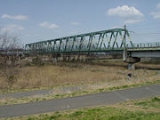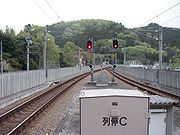
Itsukaichi Line
Encyclopedia
The is a railway line operated by East Japan Railway Company
(JR East) in Tokyo
, Japan
. It links Musashi-Itsukaichi Station in the city of Akiruno
with Haijima Station
in the city of Akishima
. From there, some trains travel through to Tachikawa Station
via the Ōme Line
, and a very few continue from Tachikawa along the Chūō Line
to Tokyo Station
.
.
An extension, via switchback, operated to Musashi-Iwai Station. It closed to passenger traffic in 1971 and to freight in 1982.
 The Itsukaichi Line was built by the Itsukaichi Railway in 1925. In 1930, all sections (Tachikawa
The Itsukaichi Line was built by the Itsukaichi Railway in 1925. In 1930, all sections (Tachikawa
- Haijima
- Musashi-Itsukaichi - Musashi-Iwai) were opened. There were two competing railways between Tachikawa and Haijima: the Ōme Electric Railway (now the Ōme Line
) and the Itsukaichi Railway. In 1940, the Itsukaichi Railway was taken over by the Nambu Railway, becoming the Nambu Railway Itsukaichi Line. In 1944, Nambu Railway was nationalized and this line became the JGR
Itsukaichi Line. At the same time, the section of the line between Tachikawa and Haijima was deemed non-essential and closed. However, the Tachikawa - Musashi-Uenohara and Musahi-Uenohara - Nishi-Tachikawa
sections of the former Nambu Railway are still used by Chūō Main Line
and Nambu Line
trains traveling to and from the southern area of Tachikawa Station.
East Japan Railway Company
is the largest passenger railway company in the world and one of the seven Japan Railways Group companies. The company name is officially abbreviated as JR East in English, and as in Japanese. The company's headquarters are in Yoyogi, Shibuya, Tokyo....
(JR East) in Tokyo
Tokyo
, ; officially , is one of the 47 prefectures of Japan. Tokyo is the capital of Japan, the center of the Greater Tokyo Area, and the largest metropolitan area of Japan. It is the seat of the Japanese government and the Imperial Palace, and the home of the Japanese Imperial Family...
, Japan
Japan
Japan is an island nation in East Asia. Located in the Pacific Ocean, it lies to the east of the Sea of Japan, China, North Korea, South Korea and Russia, stretching from the Sea of Okhotsk in the north to the East China Sea and Taiwan in the south...
. It links Musashi-Itsukaichi Station in the city of Akiruno
Akiruno, Tokyo
is a city located in the western end of Tokyo Metropolis, Japan. As of 2010, the city has an estimated population of 80,621 and a population density of 1,100 persons per km². The total area was 73.34 km².-Geography:...
with Haijima Station
Haijima Station
is a railway station in Akishima, Tokyo, Japan, jointly operated by East Japan Railway Company and Seibu Railway.-Lines:Haijima is a major stop on the Ōme Line between and , with through services operating to and from via the Chūō Line...
in the city of Akishima
Akishima, Tokyo
is a city located in the western end of Tokyo Metropolis, Japan. As of 2010, the city has an estimated population of 112,521 and a population density of 6,490 persons per km²...
. From there, some trains travel through to Tachikawa Station
Tachikawa Station
is an important railway station in the city of Tachikawa, Tokyo, Japan. The JR Chūō Line passes through Tachikawa Station. The Ōme Line and Nambu Line terminate here...
via the Ōme Line
Ome Line
The is a railway line operated by East Japan Railway Company in western Tokyo, Japan. It links Tachikawa and the Chūō Line with the town of Okutama. Many Chūō Line trains operate via the Ōme Line to Ōme Station, providing non-stop service to Tokyo Station....
, and a very few continue from Tachikawa along the Chūō Line
Chuo Main Line
The , commonly called the Chūō Line, is one of the major trunk railway lines in Japan. It runs between Tokyo and Nagoya, although it is the slowest direct railway connection between the two cities; the coastal Tōkaidō Main Line is slightly faster, while the Tōkaidō Shinkansen is the fastest rail...
to Tokyo Station
Tokyo Station
is a train station located in the Marunouchi business district of Chiyoda, Tokyo, Japan, near the Imperial Palace grounds and the Ginza commercial district....
.
Stations
All stations are located in TokyoTokyo
, ; officially , is one of the 47 prefectures of Japan. Tokyo is the capital of Japan, the center of the Greater Tokyo Area, and the largest metropolitan area of Japan. It is the seat of the Japanese government and the Imperial Palace, and the home of the Japanese Imperial Family...
.
| Station | Japanese | Distance (km) | Transfers | Location | |
|---|---|---|---|---|---|
| Between stations |
Total | ||||
| 拝島 | - | 0.0 | Ōme Line Ome Line The is a railway line operated by East Japan Railway Company in western Tokyo, Japan. It links Tachikawa and the Chūō Line with the town of Okutama. Many Chūō Line trains operate via the Ōme Line to Ōme Station, providing non-stop service to Tokyo Station.... Seibu Haijima Line |
Akishima Akishima, Tokyo is a city located in the western end of Tokyo Metropolis, Japan. As of 2010, the city has an estimated population of 112,521 and a population density of 6,490 persons per km²... |
|
| 熊川 | 1.1 | 1.1 | Fussa Fussa, Tokyo is a city located in western Tokyo Metropolis, Japan. As of 2010, the city has an estimated population of 59,761 and a population density of 5,840 persons per km². The total area was 10.24 km²... |
||
| 東秋留 | 2.4 | 3.5 | Akiruno Akiruno, Tokyo is a city located in the western end of Tokyo Metropolis, Japan. As of 2010, the city has an estimated population of 80,621 and a population density of 1,100 persons per km². The total area was 73.34 km².-Geography:... |
||
| 秋川 | 2.2 | 5.7 | |||
| 武蔵引田 | 1.5 | 7.2 | |||
| 武蔵増戸 | 1.3 | 8.5 | |||
| 武蔵五日市 | 2.6 | 11.1 |
An extension, via switchback, operated to Musashi-Iwai Station. It closed to passenger traffic in 1971 and to freight in 1982.
History

Tachikawa Station
is an important railway station in the city of Tachikawa, Tokyo, Japan. The JR Chūō Line passes through Tachikawa Station. The Ōme Line and Nambu Line terminate here...
- Haijima
Haijima Station
is a railway station in Akishima, Tokyo, Japan, jointly operated by East Japan Railway Company and Seibu Railway.-Lines:Haijima is a major stop on the Ōme Line between and , with through services operating to and from via the Chūō Line...
- Musashi-Itsukaichi - Musashi-Iwai) were opened. There were two competing railways between Tachikawa and Haijima: the Ōme Electric Railway (now the Ōme Line
Ome Line
The is a railway line operated by East Japan Railway Company in western Tokyo, Japan. It links Tachikawa and the Chūō Line with the town of Okutama. Many Chūō Line trains operate via the Ōme Line to Ōme Station, providing non-stop service to Tokyo Station....
) and the Itsukaichi Railway. In 1940, the Itsukaichi Railway was taken over by the Nambu Railway, becoming the Nambu Railway Itsukaichi Line. In 1944, Nambu Railway was nationalized and this line became the JGR
Japanese Government Railways
The Japanese Government Railways was the national railway system directly operated by the central government of Japan until 1949. It is a predecessor of Japanese National Railways and the Japan Railways Group.- Name :...
Itsukaichi Line. At the same time, the section of the line between Tachikawa and Haijima was deemed non-essential and closed. However, the Tachikawa - Musashi-Uenohara and Musahi-Uenohara - Nishi-Tachikawa
Nishi-Tachikawa Station
is a train station in Tachikawa, Tokyo, Japan.- Adjacent stations :...
sections of the former Nambu Railway are still used by Chūō Main Line
Chuo Main Line
The , commonly called the Chūō Line, is one of the major trunk railway lines in Japan. It runs between Tokyo and Nagoya, although it is the slowest direct railway connection between the two cities; the coastal Tōkaidō Main Line is slightly faster, while the Tōkaidō Shinkansen is the fastest rail...
and Nambu Line
Nambu Line
The is a Japanese railway line which connects Tachikawa Station in Tachikawa, Tokyo and Kawasaki Station in Kawasaki, Kanagawa Prefecture. For most of its length, it parallels the Tama River, the natural border between Tokyo and Kanagawa prefectures. It is part of the East Japan Railway Company ...
trains traveling to and from the southern area of Tachikawa Station.
Chronology
- 24 April 1925: Itsukaichi Railway opens between Haijima (temporary) and Itsukaichi (6.6 mi, 10.62 km) stations. Haijima (temporary), Higashi-Akiru, Nishi-Akiru, Masuko, and Itsukaichi stations open.
- 15 May 1925: Extension from Haijima (temporary) Station to Haijima Station opens; Haijima (temporary) Station closes.
- 16 May 1925: Masuko Station renamed Musashi-Masuko Station.
- 1 June 1925: Itsukaichi Station renamed Musashi-Itsukaichi Station.
- September 20, 1925: Musashi-Itsukaichi - Musashi-Iwai section opens; Okuno, Musashi-Iwai stations open.
- 1 July 1926: Tamagawa Station (freight only) opens.
- 1 April 1930: Distance markers changed from miles to kilometres.
- 4 April 1930: Construction of Byōinmae Station authorized.
- 13 July 1930: Tachikawa - Haijima extension opens; Musashi-Uenohara, Gouchi, Musashi-Fukushima, Minami-Nakagami, Miyazawa, Ōgami, Musashi-Tanaka, Minami-Haijima stations open.
- 28 May 1931: Kumagawa Station opens.
- 8 December 1931: Musashi-Tanaka - Haijima-Tamagawa freight branch (1.6 km) opens; Haijima-Tamagawa Station (freight only) opens. Tamagawa Station is renamed Musashi-Tamagawa Station.
- 3 October 1940: Line taken over by Nambu Railway, becomes Itsukaichi Line. Musashi-Tamagawa Station closes.
- 1 April 1944: Line is nationalized. Byōinmae Station renamed Musashi-Hikita Station. Musashi-Uenohara, Miyazawa, and Musashi-Tanaka stations close. Origin of freight branch (Musashi-Tanama - Haijima-Tamagawa) moved to Minami-Haijima Station (+1.4 km). Distance between Musashi-Itsukaichi and Musashi-Iwai shortened by 0.1 km.
- 11 October 1944: Tachikawa - Haijima section of Main Line and Minami-Haijima - Haijima-Tamagawa section of freight branch close. Gouchi, Musashi-Fukushima, Minami-Nakagami, Ōgami, Minami-Haijima, Haijima-Tamagawa stations close.
- 17 February 1961: Haijima - Musashi-Iwai section electrified at 1,500 V DC.
- 1 February 1971: Ōkuno - Musashi-Iwai section of main line closes. Passenger service between Musashi-Itsukaichi and Ōkuno ceases; section becomes a freight branch. CTCCentralized traffic controlCentralized traffic control is a form of railway signalling that originated in North America and centralizes train routing decisions that were previously carried out by local signal operators or the train crews themselves. The system consists of a centralized train dispatcher's office that...
installed in all sections. - 15 November 1982: Musashi-Itsukaichi - Ōkuno freight branch closes; all freight services discontinued.
- 31 March 1987: Nishi-Akiru Station renamed Akigawa Station.
- 1 April 1987: Following privatization of JNRJapanese National Railways, abbreviated or "JNR", was the national railway network of Japan from 1949 to 1987.-History:The term Kokuyū Tetsudō "state-owned railway" originally referred to a network of railway lines operated by nationalized companies under the control of the Railway Institute following the nationalization...
line becomes part of JR East. - 18 March 2007: New E233 seriesE233 seriesThe is a commuter and suburban electric multiple unit type developed by East Japan Railway Company from the earlier E231 series and the E531 series design...
trains enter service. - 15 March 2008: Semi-automated door operation starts year-round using E233 series rolling stock.
External links
- Stations of the Itsukaichi Line (JR East)

